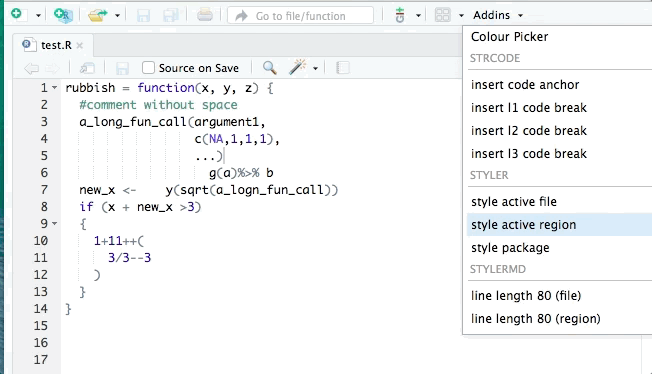The goal of styler is to provide non-invasive pretty-printing of R source code while adhering to the tidyverse formatting rules. styler can be customized to format code according to other style guides too.
The following online docs are available:
You can install the package from CRAN.
install.packages("styler")If you don’t use styler interactively (i.e. not from the R prompt or
RStudio Addin), make sure you authorize {R.cache} once to set up a
permanent cache. If you use it interactively, you will be asked to grant
this permission once. See ?caching for details.
Or get the development version from GitHub:
# install.packages("remotes")
remotes::install_github("r-lib/styler")You can style a simple character vector of code with style_text():
library("styler")
ugly_code <- "a=function( x){1+1} "
style_text(ugly_code)
#> a <- function(x) {
#> 1 + 1
#> }There are a few variants of style_text():
-
style_file()styles .R, .Rmd .Rnw and .Rprofile, files. -
style_dir()styles all .R and/or .Rmd files in a directory. -
style_pkg()styles the source files of an R package. -
RStudio Addins for styling the active file, styling the current package and styling the highlighted code region.
You can decide on the level of invasiveness with the scope argument. You can style:
-
just spaces.
-
spaces and indention.
-
spaces, indention and line breaks.
-
spaces, indention, line breaks and tokens.
ugly_code <- "a=function( x){1+1} "
style_text(ugly_code, scope = "spaces")
#> a = function(x) {1 + 1}Note that compared to the default used above scope = "tokens":
-
no line breaks were added.
-
<-was not replaced with=.
While spaces still got styled (around = in (x)).
This was just the tip of the iceberg. To learn more about customization options with the tidyverse style guide, see the help file for `tidyverse_style for a quick overview or the introductory vignette.
-
style roxygen2 code examples.
-
do not re-style deliberate code alignment.
-
ignore some lines for styling.
-
cache styled expressions for speed.
styler functionality is made available through other tools, most notably
-
as a pre-commit hook
style-filesin https://github.com/lorenzwalthert/precommit -
usethis::use_tidy_style()styles your project according to the tidyverse style guide. -
via commenting a PR on GitHub with
\stylewhen the GitHub Action Tidyverse CI is used. The most convenient way to set this up is viausethis::use_github_actions_tidy(). -
reprex::reprex(style = TRUE)to prettify reprex code before printing. To permanently usestyle = TRUEwithout specifying it every time, you can add the following line to your.Rprofile(viausethis::edit_r_profile()):options(reprex.styler = TRUE). -
you can pretty-print your R code in RMarkdown reports without having styler modifying the source. This feature is implemented as a code chunk option in knitr. use
tidy = "styler"in the header of a code chunks (e.g.```{r name-of-the-chunk, tidy = "styler"}), orknitr::opts_chunk$set(tidy = "styler")at the top of your RMarkdown script. -
Adding styler as a fixer to the ale Plug-in for VIM.
-
pretty-printing of drake workflow data frames with
drake::drake_plan_source(). -
Adding styler with emacs-format-all-the-code for Emacs.
-
The official web documentation of styler, containing various vignettes function documentation as well as a change-log.
-
Blog post about how you can customize styler without being an expert.
-
A tidyverse.org blog post introducing the functionality of styler and a follow-up post that introduces the new features since release 1.0.0.
-
The wiki of Google Summer of Code 2017 or the pkgdown page contain information related to the initial development phase during Google Summer of Code 2017.

